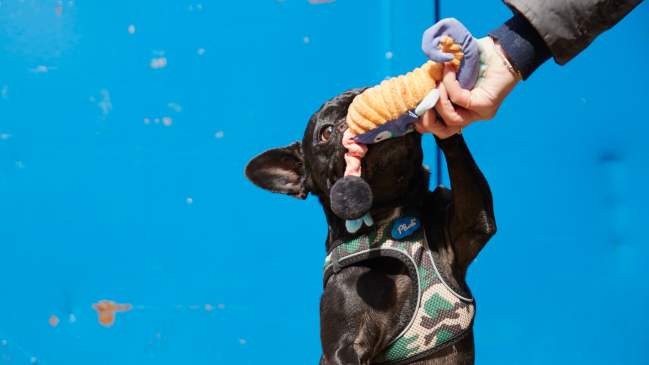Like furry strong-willed children, dogs often seem to have a mind of their own. But you can keep them safe and happy with a little patience, love, and training. Start by teaching your dog some basic commands.
Basic Training: What to Know Before You Start
Before you get down to business, it's important to set your dog up for success. According to the American Kennel Club (AKC), you should:
Find a calm, quiet place to train your dog before testing out commands in public.
Consider your dog's personality and take an individualized approach to training them.
Be consistent with the any language and gestures you use for each command.
Stick to a schedule as much as possible, but keep the training sessions short and simple.
Be patient with your dog throughout the training process.
Use positive reinforcement and reward your dog for their progress.
Make it fun and play along with your dog while teaching them new commands.
How Long Does It Take to Teach Basic Dog Commands?
That's up to your dog, but in general, think of obedience training as a marathon, not a sprint. Some of the basic commands can be learned in a matter of days or weeks.
What Is the Easiest Dog Command to Teach?
There is no set order to go in when teaching your dog basic commands, according to the AKC. Though it can help to get started with the one you think your dog might be the most receptive to.
Essential Dog Commands To Start With
See if you can get your dog to obey these basic commands — and remember, some tricks may be easier to teach than others.
1. Watch Me

This command is a great place to start because it teaches your dog to obey your commands and respect your authority as the pack leader. It can also serve as a good way to reset, should the training sessions get unruly or "get away from you," so to speak. Establish eye contact, and use a treat to guide the dog's attention from their nose to your face, adding the phrase "watch me" or "look at me" to the motion.
2. Sit
It doesn't get more basic than the "sit" command. Using a treat, start by putting it near the dog's nose and then slowly lifting the treat away at an angle. Ideally, the dog will lower their flank until they are in the seated position. Say the "sit" command, and repeat the exercise until the dog has learned and understands the command. Throw in some extra love and affection when they get it right — your pup deserves it.
3. Stay
The "stay" command is important in every setting, but is especially useful outside and when a dog is off leash. It can help to teach your dog to sit first, and then use the sit command to prep your dog to learn how to stay.
Hold an open palm out and slowly back away from the dog a few steps at a time. This one may take a little effort because your dog's instinct will be to follow you — don't worry if it takes a while for them to figure it out. Start with a few steps at first, and reward them with a treat when they have mastered the ability to stay until called. Gradually increase the distance and wait time as they get more disciplined and learn to understand and obey the command.
4. Come Here
Whether you're calling them in from the yard, another room, or a potentially awkward encounter at the dog park, teaching a dog to come when you call should be a priority for every dog owner. To get started, put your dog on a leash and stand at a distance, but down at their level. While holding a treat (see a pattern here?), say the "come here" command to call the dog towards you while using the leash to gently guide them in your direction. Once they arrive, feed them the treat and acknowledge their brilliance.
This command has two parts: Once you are confident that the dog has mastered the command on leash, remove the leash to test if they can still obey the command. Repeat as needed until successful.
5. Down
The "down" command is a submissive action, which can be more challenging to teach. Start by putting a delicious-smelling treat and hold it in a closed fist. Place your hand at the dog's snout to let them pick up the scent, and then bring the hand to the ground. When the dog comes to the ground, drag your fist slowly towards you so that the dog moves towards you in a crawl position. Once they've met you, say the command, offer up the treat, and throw a little praise their way.
6. Drop It

From shoes, to stuffed animals, to stolen pork chops from your dinner plate, your dog needs to know when to let go of an object. It's also important from a safety standpoint, to prevent your dog from picking up or eating something that can be harmful to their health.
The easiest way to approach the "drop it" or "leave it" command is through the old bait and switch. Holding a treat in each hand (closed fists). Then instruct your dog to leave what's in your right hand, using the left hand as a reward. Be sure to withhold the treat from your left hand until the dog has fully backed away from the treat in your right hand.
Stick With It
Once your dog has mastered one command, move on to the next — your dog is likely ready and willing to keep the training going. "Dog training is not just for puppies. It's an ongoing process to build good behavior throughout the dog's lifetime," adds Christie Branch, professional dog trainer at Paw Commons in San Diego, California.
